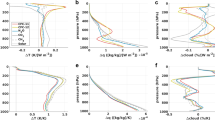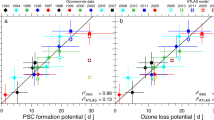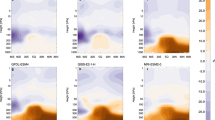Abstract
OBSERVATIONS from satellite and ground-based instruments1–3 indicate that between 1979 and 1990 there have been statistically significant losses of ozone in the lower stratosphere of the middle to high latitudes in both hemispheres. Here we determine the radiative forcing of the surface–troposphere system4–6 due to the observed decadal ozone losses, and compare it with that due to the increased concentrations of the other main radiatively active gases (CO2, CH4, N2O and chlorofluorocarbons) over the same time period. Our results indicate that a significant negative radiative forcing results from ozone losses in middle to high latitudes, in contrast to the positive forcing at all latitudes caused by the CFCs and other gases. As the anthropogenic emissions of CFCs and other halocarbons are thought to be largely responsible for the observed ozone depletions1, our results suggest that the net decadal contribution of CFCs to the greenhouse climate forcing is substantially less than previously estimated.
This is a preview of subscription content, access via your institution
Access options
Subscribe to this journal
Receive 51 print issues and online access
$199.00 per year
only $3.90 per issue
Buy this article
- Purchase on Springer Link
- Instant access to full article PDF
Prices may be subject to local taxes which are calculated during checkout
Similar content being viewed by others
References
WMO/UNEP Scientific Assessment of Ozone Depletion: 1991 (WMO. Geneva, in the press).
Stolarski, R. S., Bloomfield, P., McPeters, R. D. & Herman, J. R. Geophys. Res. Lett. 18, 1015–1018 (1991).
McCormick, M. P., Veiga, R. E. & Chu, W. P. Geophys. Res. Lett. (in the press).
Shine, K. P., Derwent, R. G., Wuebbles, D. J. & Morcrette, J.-J. in Climate Change: The IPCC Scientific Assessment (eds Houghton, J. T. et al.) 41–68 (Cambridge University Press, 1990).
Ramanathan, V. & Dickinson, R. E. J. atmos. Sci. 36, 1084–1104 (1979).
Ramanathan, V. et al. Rev. Geophys. 25, 1441–1482 (1987).
Hansen, J. et al. Science 213, 957–966 (1981).
Fels, S. B. & Kaplan, L. D. J. atmos. Sci. 33, 779–789 (1975).
Fels, S. B., Mahlman, J. D., Schwarzkopf, M. D. & Sinclair, R. W. J. atmos. Sci. 37, 2265–2297 (1980).
Kiehl, J. T. & Boville, B. A. J. atmos. Sci. 45, 1798–1817 (1988).
London, J. College of Engineering, New York Univ. Rep. contract AF19(122)–165 (NTIS No 117227) (1957).
Mahlman, J. D. & Umscheid, L. in Dynamics of the Middle Atmosphere (eds Holton, J. R. & Matsuno, T.) 501–525 (Terrapub, Tokyo, 1984).
Shine, K. P. J. atmos. Sci. 48, 1513–1518 (1991).
Slingo, A. & Schrecker, H. M. Q. Jl R. met. Soc. 108, 407–426 (1982).
Malkmus, W. J. opt. Soc. Am. 57, 323–329 (1967).
Solomon, S. et al. Nature 321, 755–758 (1986).
Kiehl, J. T. & Solomon, S. J. atmos. Sci. 43, 1525–1534 (1986).
Shine, K. P. Q. Jl R. met. Soc. 113, 603–633 (1987).
Lacis, A. A., Wuebbles, D. J. & Logan, J. A. J. geophys. Res. 95, 9971–9981 (1990).
Ramanathan, V., Cicerone, R. J., Singh, H. B. & Kiehl, J. T. J. geophys. Res. 90, 5547–5566 (1985).
WMO Report of the International Ozone Trends Panel 1988, ch. 6, Global Ozone Research and Monitoring Project Rep. No. 18 (1989).
Kiehl, J. T., Boville, B. A. & Briegleb, B. P. Nature 332, 501–504 (1988).
Shine, K. P. Geophys. Res. Lett. 13, 1331–1334 (1986).
Angell, J. K. J. Clim. 1, 1296–1313 (1988).
Oort, A. & Liu, H. J. Clim. (in the press).
WMO Scientific Assessment of Stratospheric Ozone: 1989, ch. 1, Global Ozone Research and Monitoring Project Rep. No. 20, (1990).
Wang, W.-C. Dudek, M. P., Liang, X.-Z. & Kiehl, J. T. Nature 350, 573–577 (1991).
Author information
Authors and Affiliations
Rights and permissions
About this article
Cite this article
Ramaswamy, V., Schwarzkopf, M. & Shine, K. Radiative forcing of climate from halocarbon-induced global stratospheric ozone loss. Nature 355, 810–812 (1992). https://doi.org/10.1038/355810a0
Received:
Accepted:
Issue Date:
DOI: https://doi.org/10.1038/355810a0
This article is cited by
-
Stratospheric ozone, UV radiation, and climate interactions
Photochemical & Photobiological Sciences (2023)
-
Externally forced symmetric warming in the Arctic and Antarctic during the second half of the twentieth century
Geoscience Letters (2022)
-
Century-long column ozone records show that chemical and dynamical influences counteract each other
Communications Earth & Environment (2022)
-
Fingerprint of ozone depletion in the spatial and temporal pattern of recent lower-stratospheric cooling
Nature (1996)
-
Development of a risk-hedging CO2-emission policy, part I: Risks of unrestrained emissions
Climatic Change (1996)
Comments
By submitting a comment you agree to abide by our Terms and Community Guidelines. If you find something abusive or that does not comply with our terms or guidelines please flag it as inappropriate.



